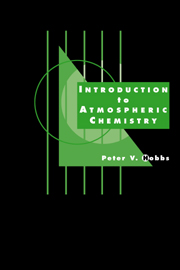Book contents
- Frontmatter
- Contents
- Preface
- 1 Evolution of the Earth's atmosphere
- 2 Half-life, residence time, and renewal time of chemicals in the atmosphere
- 3 Present chemical composition of the atmosphere
- 4 Interactions of solar and terrestrial radiation with atmospheric trace gases and aerosols
- 5 Sources, transformations, transport, and sinks of chemicals in the troposphere
- 6 Atmospheric aerosols
- 7 Cloud and precipitation chemistry
- 8 Tropospheric chemical cycles
- 9 Air pollution
- 10 Stratospheric chemistry
- Appendix I Exercises
- Appendix II Answers to exercises in Appendix I and hints and solutions to the more difficult exercises
- Appendix III Atomic weights
- Appendix IV The International System of Units (SI)
- Appendix V Some useful numerical values
- Appendix VI Suggestions for further reading
- Index
1 - Evolution of the Earth's atmosphere
Published online by Cambridge University Press: 05 June 2012
- Frontmatter
- Contents
- Preface
- 1 Evolution of the Earth's atmosphere
- 2 Half-life, residence time, and renewal time of chemicals in the atmosphere
- 3 Present chemical composition of the atmosphere
- 4 Interactions of solar and terrestrial radiation with atmospheric trace gases and aerosols
- 5 Sources, transformations, transport, and sinks of chemicals in the troposphere
- 6 Atmospheric aerosols
- 7 Cloud and precipitation chemistry
- 8 Tropospheric chemical cycles
- 9 Air pollution
- 10 Stratospheric chemistry
- Appendix I Exercises
- Appendix II Answers to exercises in Appendix I and hints and solutions to the more difficult exercises
- Appendix III Atomic weights
- Appendix IV The International System of Units (SI)
- Appendix V Some useful numerical values
- Appendix VI Suggestions for further reading
- Index
Summary
The composition of the Earth's atmosphere is unique within the solar system. The Earth is situated between Venus and Mars, both of which have atmospheres consisting primarily of CO2 (an oxidized compound); the outer planets (Jupiter, Saturn, Uranus, Neptune) are dominated by reduced compounds, such as CH4. By contrast, CO2 and CH4 are only minor (although very important) constituents of the Earth's atmosphere. Nitrogen represents ~78% of the molecules in air, and life-sustaining oxygen accounts for ~21%. The presence of so much oxygen is surprising, since it might appear to produce a combustible mixture with many of the other gases in air (e.g., sulfur to form sulfates, nitrogen to form nitrates, hydrogen to form water).
The Earth's atmosphere is certainly not in chemical equilibrium, since the concentrations of N2, O2, CH4, N2O, and NH3 are much higher than they would be for perfect equilibrium. Why is this so? A clue is provided by Table 1.1, which lists the five most common elements in the Earth's atmosphere, biosphere, hydrosphere, crust, mantle, and core. Four of the most abundant elements in the atmosphere (nitrogen, oxygen, hydrogen, and carbon) are also among the top five most abundant elements in the biosphere. This suggests that biological processes have played a dominant role in the evolution of the Earth's atmosphere and that they are probably responsible for its present chemical nonequilibrium state. However, as we will see, this has occurred in relatively recent times. In this chapter we will speculate on the development of the Earth's atmosphere since it was first formed some 4.5 billion years ago (4.5 Ga), at which time it probably had no (or very little) atmosphere.
- Type
- Chapter
- Information
- Introduction to Atmospheric Chemistry , pp. 1 - 12Publisher: Cambridge University PressPrint publication year: 2000



